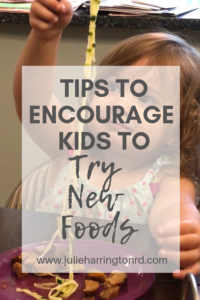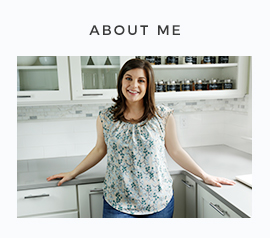Kids Eat Right Month™, celebrated each August, focuses on the importance of healthful eating and active lifestyles for kids and families.

This time last year I was just wrapping up my kids’ culinary camp which turned a few picky eaters into food explorers. While I do not have kids myself (just yet! .. well does a fur child count?) I love working with children introducing them to new foods and help them find joy in cooking.
I chatted with a few friends with young children about their strategies of ways to encourage their children with trying new foods.
Take your kids grocery shopping
Previously working as a retail dietitian, I would encourage this with parents and caregivers all the time. Just simply getting them involved in the process of grocery shopping and seeing there are so many different kinds of food available is a good start.
Emily Kyle, RDN, CLT, HCP, holistic health & wellness + cannabis educator of Emily Kyle Nutrition, turned the chore of grocery shopping with her son into “Friday Night Date Night”. They enjoy dinner & free live music in the cafe of Wegmans before going grocery shopping. She says this is helpful for so many reasons because, “We’re not hungry when we go shopping, it is later at night so the store is not busy when we do shop, and he gets to enjoy the experience and turn it from something stressful or rushed to something mindful and fun.”
Jessica Levinson, RD, culinary nutrition expert of jessicalevinson.com and mom of 7-year-old twin girls, admits when she takes her girls shopping, “it’s fun and sometimes infuriating.”
I get it .. sometimes you just want to get the chore of food shopping out of the way for the busy week ahead, but at other times encourage your kids to join you. Taking your kids shopping gives them an opportunity to see and learn about a wider variety of foods than just what comes home with you. Plus, it’s a great opportunity to spend time together, talk about healthy foods, where food comes from, and may even help motivate a picky eater to try something new.
Let them pick out their own items
Levinson and her girls work off her grocery list but also welcome them to pick out anything from the produce section that they want to try. She said, “In other parts of the store if they find items they want to try we will look them over together to read the labels, check out the ingredients, and determine if it’s a product that belongs in our house.” which is a great time for gentle nutrition education.
Sara Haas, RD, culinary dietitian of sarahaas.com heads to the produce department with her daughter. She says, “I always ask her about what produce she wants as well as snacks. She picks and we look at it together to decide if it’s something we need.”
Kyle also stops in the produce aisle as well and encourages her son to pick the “Produce Pick of the Week”. She notes, “This has enhanced his ability to identify and recognize a wide variety of produce, and encouraged him to be brave and try new things. We’ve tried everything from dragon fruit to papaya, bok choy, and rainbow carrots. It’s a fun reward for him and a good habit for me to instill in him.”
Diana Rice, RD of The Baby Steps Dietitian and lactation counselor, has fun seeing what items her kids gravitate toward in the produce department. Rice says it helps inspire her to even try something new. “When I’m on my own, I usually just pick up the same old produce items that are easy to prep and I know the whole family likes. My kids inspire me to try something new!”
Go on a scavenger hunt in the store
Use your grocery list or even a recipe to have your helpers find the items in the store. This keeps them busy but also helpful within the process. If hunting for ingredients for a recipe, have them help you make that recipe from all the ingredients they found.

Cook together
Having your children help you prepare family meals is one of the most effective ways to encourage them to try new foods and improve their overall diet quality, both now and later in life.
In March, the Journal of Nutrition Education and Behavior published the results of a 10-year longitudinal study conducted by researchers at the University of Minnesota’s School of Public Health. The aim of the study, which tracked more than 1,100 participants, was to answer a simple question: Can knowing how to cook as a young person lead to healthier eating practices in adulthood? The researchers arrived at a compelling—if unsurprising—conclusion: It can. (source)
.. with ingredients, you may not even like yourself
What if there are certain foods as a parent or caregiver do you not like yourself?
Stephanie Corbo, a middle school teacher and mom of two (and one of my best friends!), encourages her children to try whatever they are interested in trying. She says, “If they want to try an ingredient or food, I would never stand in their way from exploring new flavors.”
Levinson notes that she personally does not enjoy bananas but doesn’t discourage her children from enjoying them. She says, “Just because I don’t care for something doesn’t mean my children shouldn’t be exposed to it and determine for themselves if they like it. Role modeling is so important when feeding kids, and showing them that I’ll cook something even if I don’t like is part of that modeling.”
Rice doesn’t currently have that issue as there isn’t many foods she personally dislikes, but notes if that does come up in the future, she said, “if they came to love something that’s not my favorite somehow, I would try to regularly incorporate it. It’s important to respect their preferences. I think it’s also important to demonstrate that it’s okay to not like a food. So just like they have foods they don’t prefer, I think they would enjoy knowing that something is ‘not mommy’s favorite’.”

Let them choose
Keep them involved in the conversation. From experience in my kids cooking classes, I found the more they are involved in the choices, the more likely they were to enjoy it. Produce for Kids has really great resources to support these efforts.
With school starting the thought of packing lunches can be stressful, but if they have a chart to choose from, they get the choice of what they will have packed and as the parent or caregiver takes some of the stress away of figure out what to pack.

Keep introducing the same food in new ways
Levinson’s girls are very familiar with the concept that it takes 15-20 tries to make a real decision about a food. While Rice agrees to the 15-20 range she also notes it can take longer.
Need help keeping track of the new foods you are introducing? Utilize this Food Exposure Chart.
I personally like to introduce a new food in multiple ways. In one of my classes, we cooked cauliflower in five different ways. It was interesting to see how the taste and texture preferences between the children varied drastically, but at the end of the day, they were all enjoying cauliflower at least one way.
Corbo notes she is blessed to have two kids who are not picky eaters, eating everything from lobster to hot dogs. She notes, “I’ve found that if I make eating fun, they’re more willing to try new things. My husband makes all sorts of vehicle noises as he spirals the fork through the air, and the kids love it.”
As a recipe developer, Haas is always whipping up new recipes in the kitchen. Her daughter will try just about everything, which Haas thinks is awesome. She wants her to know as much about food as she can. And all aspects of it too!
Kyle explains to her son how much her own taste buds have changed throughout her lifetime, and provide examples, so he knows that his tastes will change over time too.
Every family is different and everyone’s tastes buds are different. Utilize these strategies and tweak them to work best for you and your family. Have fun cooking and trying new foods together!







